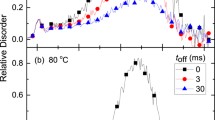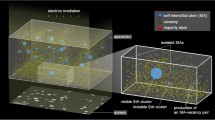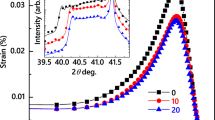Abstract
Atomistic simulations are employed to investigate the dynamical behavior of atoms in cubic silicon carbide (SiC) following a 5 keV radiation knock. Specifically, we have computed the time-resolved van Hove self-correlation function, Gs(r,t), separately for the silicon and carbon sub-lattices. Our goal is to probe the early radiation damage mechanisms using a dynamical methodology. The simulation results show that the carbon atoms engage in a dynamic hopping mechanism as the system recovers from the radiation knock. The silicon atoms, however, exhibit a strikingly different behaviour: the time variation of 4πr2Gs(r,t) indicates a dynamic tension between the crystalline and disordered regions of the Si sub-lattice. The power-law tail of the 4πr2Gs(r,t) correlation for silicon atoms suggests a scale-free self-organized critical (SOC) state – a possible precursor to the collapse of the Si sub-lattice.
Similar content being viewed by others
References
S.J. Zinkle, K. A. Terrani, J. C. Gehin, L. J. Ott, and L. L. Snead, “Accident tolerant fuels for LWRs: A perspective,” Journal of Nuclear Materials, vol. 448, pp. 374–379, 2014/05/01/2014.
G. L. Harris, Properties of silicon carbide: Iet, 1995.
R. Devanathan, T. D. de la Rubia, and W. Weber, “Displacement threshold energies in ß - SiC,” Journal of nuclear materials, vol. 253, pp. 47–52, 1998.
R. Devanathan and W. J. Weber, “Displacement energy surface in 3C and 6H SiC,” Journal of Nuclear Materials, vol. 278, pp. 258–265, 2000.
J. Bernholc, S. A. Kajihara, C. Wang, A. Antonelli, and R. F. Davis, “Theory of native defects, doping and diffusion in diamond and silicon carbide,” Materials Science and Engineering: B, vol. 11, pp. 265–272, 1992/01/15 1992.
W. G. Wolfer, “1.01 - Fundamental Properties of Defects in Metals A2 - Konings, Rudy J.M,” in Comprehensive Nuclear Materials, ed Oxford: Elsevier, 2012, pp. 1–45.
X. Yuan and L. W. Hobbs, “Modeling chemical and topological disorder in irradiation-amorphized silicon carbide,” Nuclear Instruments and Methods in Physics Research Section B: Beam Interactions with Materials and Atoms, vol. 191, pp. 74–82, 2002/05/01/ 2002.
L. Snead and J. Hay, “Neutron irradiation induced amorphization of silicon carbide,” Journal of nuclear materials, vol. 273, pp. 213–220, 1999.
W. Weber, N. Yu, and L. Wang, “Irradiation-induced amorphization in ß -SiC,” Journal of nuclear materials, vol. 253, pp. 53–59, 1998.
F. Gao and W. J. Weber, “Atomic-scale simulation of 50 keV Si displacement cascades in ß - SiC,” Physical Review B, vol. 63, p. 054101, 2000.
F. Gao and W. J. Weber, “Mechanical properties and elastic constants due to damage accumulation and amorphization in SiC,” Physical Review B, vol. 69, p. 224108, 2004.
F. Gao and W. J. Weber, “Atomic-scale simulation of 50 keV Si displacement cascades in B-SiC,” Physical Review B, vol. 63, p. 054101, 12/22/2000.
F. Gao, W. J. Weber, and W. Jiang, “Primary damage states produced by Si and Au recoils in SiC: A molecular dynamics and experimental investigation,” Physical Review B, vol. 63, p. 214106,05/14/2001.
C. Jiang, M.-J. Zheng, D. Morgan, and I. Szlufarska, “Amorphization driven by defect-induced mechanical instability,” Physical review letters, vol. 111, p. 155501, 2013.
P. Hopkins, A. Fortini, A. J. Archer, and M. Schmidt, “The van Hove distribution function for Brownian hard spheres: Dynamical test particle theory and computer simulations for bulk dynamics,” The Journal of chemical physics, vol. 133, p. 224505, 2010.
J. Tersoff, “Carbon defects and defect reactions in silicon,” Physical review letters, vol. 64, p. 1757, 1990.
J. Tersoff, “Modeling solid-state chemistry: Interatomic potentials for multicomponent systems,” Physical Review B, vol. 39, pp. 5566–5568, 03/15/ 1989.
J. F. Ziegler and J. P. Biersack, “The Stopping and Range of Ions in Matter,” in Treatise on Heavy-Ion Science: Volume 6: Astrophysics, Chemistry, and Condensed Matter, D. A. Bromley, Ed., ed Boston, MA: Springer US, 1985, pp. 93–129.
Author information
Authors and Affiliations
Rights and permissions
About this article
Cite this article
Lowe, W., Eapen, J. Using Space-Time Correlations to Identify Transient Defects. MRS Advances 3, 1755–1760 (2018). https://doi.org/10.1557/adv.2018.196
Published:
Issue Date:
DOI: https://doi.org/10.1557/adv.2018.196




